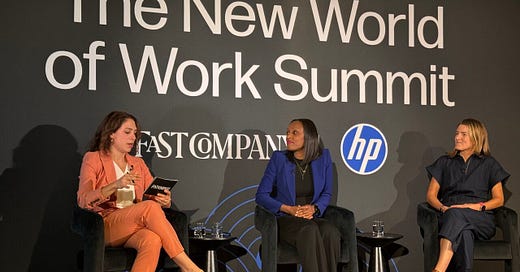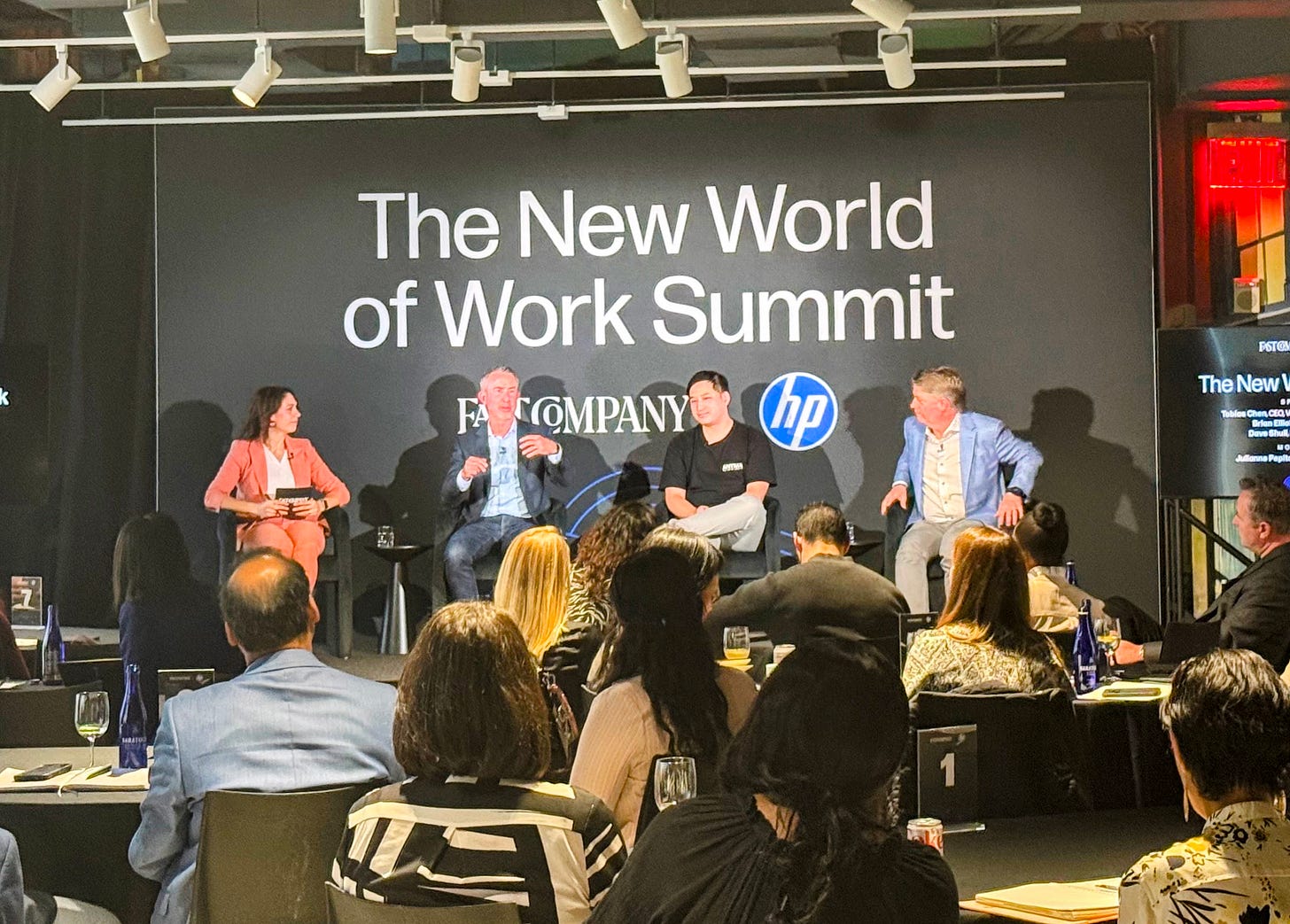When it comes to enabling change in how we work – addressing key issues like hybrid work and generative AI – are there three legs to the stool, or four? We've all been obsessing over the "three-legged stool" of great employee experiences: HR, Real Estate & Workplace, and IT teams.
At a dinner discussion of the topic in NYC, Workshape CEO Brett Hautop pointed out the fourth key group: internal communications. I’ve never seen success without all four at the table.
When we talk about creating exceptional employee experiences, we often focus on HR initiatives or Workplace efforts. When we talk about generative AI, it’s HR and IT (Moderna steals attention for slamming them together).
At Fast Company’s New World of Work Summit, HP's Dave Shull and Workday CIO Rani Johnson both said it: "We need deeper CHRO/CIO partnerships, not the old silos."
Here's the thing everyone's missing: while we're all throwing rocks at IT (because we do that when WiFi acts up or our favorite SaaS vendor has an outage), these teams are quietly having a meltdown. And that's a problem for everyone who uses technology at work. Aka, all of us.
Julianne Pepitone, Rani Johnson, Helen Sheirbon courtesy of Laurel Prime
Trust Issues and Connection Problems
At the Fast Company event, they split CIOs into groups with a choice: talk about driving AI adoption or building team connection. Gen AI, right? It’s a group of CIOs!
Connection won by a landslide. Not even close. Like every other set of leaders, the big challenges are in how well we work together – the foundations for change.
When I said the biggest thing holding organizations back was "trust," the room practically exploded with agreement. Employees won't adopt new AI tools they fear might replace them. Executives under pressure and lacking trust in their employees (and really, in their managers) crank up return-to-office mandates. It's a doom loop where nobody wins and nothing gets better.
The other clear challenge: we've squeezed out all the "play time" at work. The "do more with less" mantra has eliminated everything that doesn't directly drive outcomes. Time in the weekly team meeting for an icebreaker or just to chat? Gone. Experimenting with new tools by testing them on topics that aren’t relevant to the task at hand? Nope. Even the critical time needed to actually learn AI before trying to build with it? Squeezed out.
That's not sustainable. And it's definitely not smart.
The IT Generalist Nightmare
In prep for that Fast Company panel, I’d read Auvik’s IT Trends 2025 report. The numbers are... not great. 44% of IT professionals report having "more work than can be productively done," and 78% say stress is preventing them from learning new skills.
Even the people responsible for keeping your digital world running can't find time to stay current with technology. I called up Auvik CEO Doug Murray to ask his take on what’s driving this.
Doug explained the core problem: "The world during the pandemic moved away from one where you'd have a small IT team with a series of specialty areas. We've seen a remarkable increase in people that categorize themselves as being more generalists. Companies want people that are athletes—that can be generalists."
Translation: Companies want IT unicorns who can work on cloud migrations before lunch, debug my Zoom problems after lunch, implement AI governance policies before dinner, and somehow still have energy to troubleshoot the network at 9pm.
Oh, and they want this done with smaller teams. Because we’re squeezing out the “shared services” that actually power our teams, and too many execs think an Agent (that doesn’t exist yet) can already do the job. Those demos are pretty great…
The Remote Work Plot Twist
Despite all the return-to-office noise, 63% of IT workers are still supporting remote employees more than half the time. Many smart companies are leaning into it, but Gartner’s Tori Paulman reports that their data shows the most significant RTO trend is playing out in the US is among IT workers.
Doug's take? "We're largely distributed, which gives us an incredible competitive advantage in terms of where we can hire." Smart leaders are using flexibility as a recruiting weapon while others are still fighting the last war.
Supporting remote work means IT teams are juggling on-premise infrastructure, cloud services, SaaS applications, and security across multiple environments simultaneously. It's like being asked to repair three different cars while they're all driving down the highway.
The most experienced IT people are carrying the heaviest load. Among IT pros with 10+ years of experience, 47% work more than 40 hours weekly, compared to just 31% of those with less than 5 years of experience.
Even more alarming, 23% of Boomer-generation IT workers report working over 50 hours weekly. They're the ones with the institutional knowledge to understand all the legacy systems and the context behind past technology decisions. As these veterans retire over the next decade, companies face a massive knowledge transfer problem.
Tool Sprawl: The Digital Hoarder's Paradise
Half of IT professionals are managing 10+ different tools that don't talk to each other. It's like having a garage full of power tools, but none of them use the same battery.
"When you look at SaaS or infrastructure such as cybersecurity, there's not going to be one widget that solves for everything," Doug noted. "It's inevitable that you're going to have to manage a number of them. The question is, how many is reasonable?"
The answer is apparently "more than seems humanly possible," especially since many organizations are juggling hybrid environments that mix legacy on-premise systems with cloud solutions and that isn’t chaning.
Making it worse, 44% cite "lack of real-time network visibility" as a major productivity blocker. Doug told me about customers who track their entire network infrastructure with... of course... a spreadsheet. "Bob left the company, and we have this list of these 42 assets that we have, or think that's what we have..."
Spoiler alert: They usually have way more than 42 assets, and half the information is wrong.
The AI Hope and Hype Machine
So will AI save the day? Maybe. Doug's company has automated about a third of customer queries using AI, which sounds promising. But 34% of organizations still don't even have AI security policies. The assumption that saying “no” will work is foolhardy; saying nothing opens up every door.
How do you drive adoption? Lots of it is emotional work as well as team-based training, but you can’t do it while flying blind. As Prologis CPO Nathaalie Carey puts it: "What gets measured gets done."
Workday’s Rani Johnson gets it right: she demands anonymyzed data from AI vendors to identify which teams are actually succeeding. "Knowing that 30% of your organization are regular daily users of a tool is nice; knowing which pockets in Sales or Engineering have gone all-in helps you find your champions."
But Doug raises a critical concern: "The larger concern is actually the younger people coming into the market. If you have something where you can build something that gets it to 80%, and then you're giving it to the more senior tenure people to get it from 80% or 90% to 100%. A lot of that work that was going to 80% was typically done by younger engineers."
In other words: How do junior IT professionals learn their craft when AI is doing all the foundational work? It's like teaching someone to drive by only letting them parallel park.
Julianne Pepitone, me (mouting off), Tobias Chen, Dave Shull. Photo courtesy of Caitlin Pike
Back to Basics
Based on insights from the wide range of leaders at the Fast Company event and conversations with Doug, here's what smart leaders are doing:
Build trust first. Set clear goals, link them to purpose, and let teams figure out how to get there. “These are just the basics of good management” as Yvonne Gerald put it to me.
Create AI policies yesterday. One-third of companies have no AI policies while their employees are already using these tools. That's like having no speed limits while everyone's driving race cars.
Carve out learning time. Doug's company dedicates weekly “office hours” to AI learning. When 78% of IT pros say stress prevents upskilling, something's got to give.
Embrace flexibility, build connection. Use flexibility to recruit better talent instead of fighting reality. But as everyone at the Fast Company event agreed: regular in-person connection still matters, and we’ve under-invested.
The Bottom Line
That should all sound exceedingly familiar. We're asking our IT teams—along with HR and Workplace teams—to be superheroes on reduced budgets while they're managing more complexity than ever. They're running major initiatives while simultaneously putting out the daily fires that never stop coming.
The companies that figure out how to support their IT teams—with better tools, clearer priorities, and sustainable workloads—will have a massive advantage in the AI transition. The ones that don't? Well, good luck when Bob retires and takes all the network passwords with him.
These teams are the foundation that makes everything else possible. Here's what puzzles me: if your organization struggled with the relatively modest shifts needed for hybrid work, how will it handle the far more fundamental changes required for AI integration? The same principles apply—outcomes-based management, willingness to experiment, and building trust.
You can't skip the foundation and expect the house to stand.
How’s your IT team holding up, and what’s holding them back?
ICYMI
The Widening Workplace Gap: How Policy Shifts Are Creating Leaders And Laggards.
The folks at Allwork.Space ran a column that I penned about the growing chasm between Workplaces where leadership is aligned on how they’re moving forward vs those stuck in a past that never was.
AI as Normal Technology.
Arvind Narayanan and Sayash Kapoor lay out the central thesis for their upcoming book, that while generative AI will be disruptive, it’s not an impending, potentially uncontrollable superintelligence. They argue that AI should be viewed as a "normal technology" like electricity or the internet, that is yes transformative but not world-shattering. I slept better after reading it, at least for one night.
People Managing People
David Rice and I talked on his podcast about how failing at hybrid work is basically failing at distributed work is basically failing at management. Have a listen.
You’re still here?
Thank you! Feedback and ideas welcome.
Now…








Unfortunately, this is a problem in many departments, Brian. They try to do more with less and expect people to take on multiple roles. I came from higher education, and that was especially common. They’d expect one person to fill the role of three or four others, and it just doesn’t work. You get burnt out, and after a while, you can’t keep up that pace. With technology evolving so fast, expecting someone to know everything is simply unrealistic.